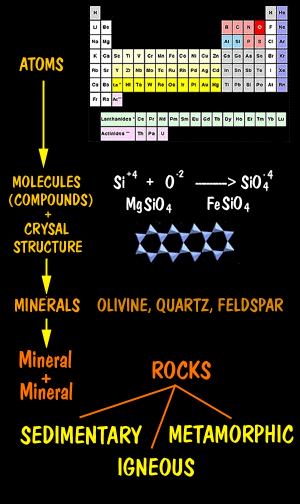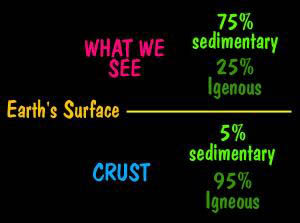
We also can infer a good deal about the temperature and pressures at depth within the earth. We can draw temperature and pressure diagrams based on real measurement, and sometimes extended them by interpolation to areas outside of our exact measurement.
Combining both of these bits of information we can predict where certain minerals have been in order to exist. We can overlay the synthetic information with the earth's temperature and pressure data, and determine where it is likely that certain minerals were created.
Diamond, for instance, requires high temperature and pressure, and to get the needed physical environment we need to be at least 150 km down in the earth.
Data gathered from evaporative deposits can tell us a good deal about the climate at the time of their deposition and microscopic animal remains are indicators of climactic conditions.
The boundaries between rock phases tell us much about the ordering of events a well as the past stresses they have under gone.
Minerals are the building blocks for rocks. By looking at the texture and content we can predict a good deal about their history. Rocks are mixtures of minerals, they formed in confined conditions and thus we do see the more obvious crystal structures that we see in the pure minerals. Rocks have definitive textures.
Many times the mineral assemblages are so tiny it takes a microscope to look into their structure. Rocks are more difficult to tell apart than minerals because they are continuous solutions and even within a given type may vary in color, grain size, and texture. They are defined by ranges not absolute uniqueness.
That being said, rocks can be classified by two properties, texture and content. A few types of rock contain only one mineral, and a special case contains none (obsidian - volcanic glass), but most contain two or more.

Depending on how we observe the outside layer of the earth, we get two perspectives of what makes it up.
If we observe the external most layer of the earth as human beings, we see about 95% of the surface covered with sediment and sedimentary rock. This is because it forms continuously from the weather process, and is an ongoing process at all times. The resultant material lays down over all others.
If we drill down past what we can see visually, we find that the vast majority of the crust of the planet is made up of igneous rocks, or metamorphic rocks that were create from igneous predecessors.
What we "visually see" is only a very thin layer on the outer most part of the earth. It is like dust on table. If we were to analyze the dust on the table, and from this one observation, we would probably miss the true composition of the table.
The picture of the earth's crust is not too distant from this model. Sedimentary rocks are like the layer of dust at the outside of the earths surface. To study the crust we need to begin with the study of its major constituent, igneous rock.
| NEXT | TOC | PREV |